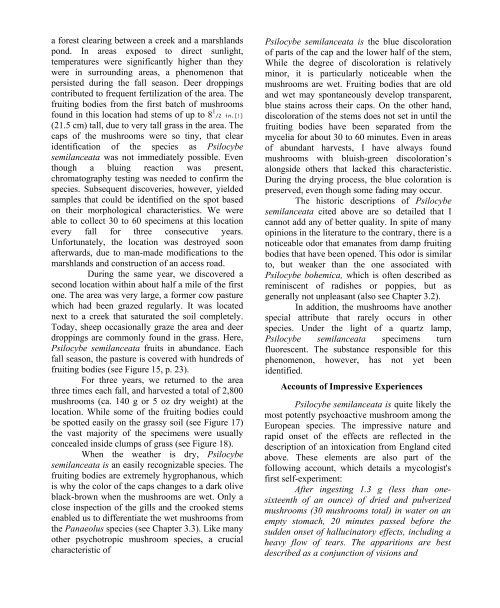Jochen Gartz - Magic Mushrooms Around the ... - preterhuman.net
Jochen Gartz - Magic Mushrooms Around the ... - preterhuman.net
Jochen Gartz - Magic Mushrooms Around the ... - preterhuman.net
Create successful ePaper yourself
Turn your PDF publications into a flip-book with our unique Google optimized e-Paper software.
a forest clearing between a creek and a marshlands<br />
pond. In areas exposed to direct sunlight,<br />
temperatures were significantly higher than <strong>the</strong>y<br />
were in surrounding areas, a phenomenon that<br />
persisted during <strong>the</strong> fall season. Deer droppings<br />
contributed to frequent fertilization of <strong>the</strong> area. The<br />
fruiting bodies from <strong>the</strong> first batch of mushrooms<br />
found in this location had stems of up to 8 1 /2 in.[!]<br />
(21.5 cm) tall, due to very tall grass in <strong>the</strong> area. The<br />
caps of <strong>the</strong> mushrooms were so tiny, that clear<br />
identification of <strong>the</strong> species as Psilocybe<br />
semilanceata was not immediately possible. Even<br />
though a bluing reaction was present,<br />
chromatography testing was needed to confirm <strong>the</strong><br />
species. Subsequent discoveries, however, yielded<br />
samples that could be identified on <strong>the</strong> spot based<br />
on <strong>the</strong>ir morphological characteristics. We were<br />
able to collect 30 to 60 specimens at this location<br />
every fall for three consecutive years.<br />
Unfortunately, <strong>the</strong> location was destroyed soon<br />
afterwards, due to man-made modifications to <strong>the</strong><br />
marshlands and construction of an access road.<br />
During <strong>the</strong> same year, we discovered a<br />
second location within about half a mile of <strong>the</strong> first<br />
one. The area was very large, a former cow pasture<br />
which had been grazed regularly. It was located<br />
next to a creek that saturated <strong>the</strong> soil completely.<br />
Today, sheep occasionally graze <strong>the</strong> area and deer<br />
droppings are commonly found in <strong>the</strong> grass. Here,<br />
Psilocybe semilanceata fruits in abundance. Each<br />
fall season, <strong>the</strong> pasture is covered with hundreds of<br />
fruiting bodies (see Figure 15, p. 23).<br />
For three years, we returned to <strong>the</strong> area<br />
three times each fall, and harvested a total of 2,800<br />
mushrooms (ca. 140 g or 5 oz dry weight) at <strong>the</strong><br />
location. While some of <strong>the</strong> fruiting bodies could<br />
be spotted easily on <strong>the</strong> grassy soil (see Figure 17)<br />
<strong>the</strong> vast majority of <strong>the</strong> specimens were usually<br />
concealed inside clumps of grass (see Figure 18).<br />
When <strong>the</strong> wea<strong>the</strong>r is dry, Psilocybe<br />
semilanceata is an easily recognizable species. The<br />
fruiting bodies are extremely hygrophanous, which<br />
is why <strong>the</strong> color of <strong>the</strong> caps changes to a dark olive<br />
black-brown when <strong>the</strong> mushrooms are wet. Only a<br />
close inspection of <strong>the</strong> gills and <strong>the</strong> crooked stems<br />
enabled us to differentiate <strong>the</strong> wet mushrooms from<br />
<strong>the</strong> Panaeolus species (see Chapter 3.3). Like many<br />
o<strong>the</strong>r psychotropic mushroom species, a crucial<br />
characteristic of<br />
Psilocybe semilanceata is <strong>the</strong> blue discoloration<br />
of parts of <strong>the</strong> cap and <strong>the</strong> lower half of <strong>the</strong> stem,<br />
While <strong>the</strong> degree of discoloration is relatively<br />
minor, it is particularly noticeable when <strong>the</strong><br />
mushrooms are wet. Fruiting bodies that are old<br />
and wet may spontaneously develop transparent,<br />
blue stains across <strong>the</strong>ir caps. On <strong>the</strong> o<strong>the</strong>r hand,<br />
discoloration of <strong>the</strong> stems does not set in until <strong>the</strong><br />
fruiting bodies have been separated from <strong>the</strong><br />
mycelia for about 30 to 60 minutes. Even in areas<br />
of abundant harvests, I have always found<br />
mushrooms with bluish-green discoloration’s<br />
alongside o<strong>the</strong>rs that lacked this characteristic.<br />
During <strong>the</strong> drying process, <strong>the</strong> blue coloration is<br />
preserved, even though some fading may occur.<br />
The historic descriptions of Psilocybe<br />
semilanceata cited above are so detailed that I<br />
cannot add any of better quality. In spite of many<br />
opinions in <strong>the</strong> literature to <strong>the</strong> contrary, <strong>the</strong>re is a<br />
noticeable odor that emanates from damp fruiting<br />
bodies that have been opened. This odor is similar<br />
to, but weaker than <strong>the</strong> one associated with<br />
Psilocybe bohemica, which is often described as<br />
reminiscent of radishes or poppies, but as<br />
generally not unpleasant (also see Chapter 3.2).<br />
In addition, <strong>the</strong> mushrooms have ano<strong>the</strong>r<br />
special attribute that rarely occurs in o<strong>the</strong>r<br />
species. Under <strong>the</strong> light of a quartz lamp,<br />
Psilocybe semilanceata specimens turn<br />
fluorescent. The substance responsible for this<br />
phenomenon, however, has not yet been<br />
identified.<br />
Accounts of Impressive Experiences<br />
Psilocybe semilanceata is quite likely <strong>the</strong><br />
most potently psychoactive mushroom among <strong>the</strong><br />
European species. The impressive nature and<br />
rapid onset of <strong>the</strong> effects are reflected in <strong>the</strong><br />
description of an intoxication from England cited<br />
above. These elements are also part of <strong>the</strong><br />
following account, which details a mycologist's<br />
first self-experiment:<br />
After ingesting 1.3 g (less than onesixteenth<br />
of an ounce) of dried and pulverized<br />
mushrooms (30 mushrooms total) in water on an<br />
empty stomach, 20 minutes passed before <strong>the</strong><br />
sudden onset of hallucinatory effects, including a<br />
heavy flow of tears. The apparitions are best<br />
described as a conjunction of visions and








![The Big Lie 9-11 and Government Complicity in Mass Murder [PDF]](https://img.yumpu.com/50957077/1/190x245/the-big-lie-9-11-and-government-complicity-in-mass-murder-pdf.jpg?quality=85)








